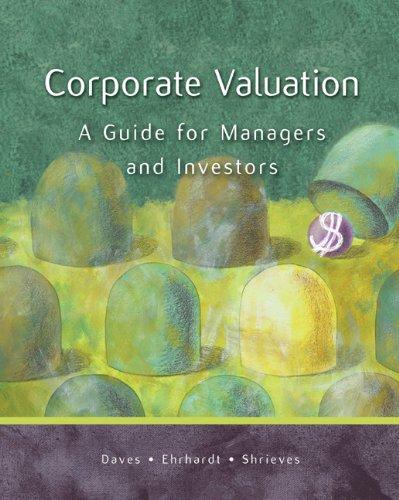Question
A capital project and budgeting decision is being considered that would involve an expansion, along with a replacement of some old equipment. The project is


A capital project and budgeting decision is being considered that would involve an expansion, along with a replacement of some old equipment. The project is expected to have a 6-year life for the firm.
The new project will require new equipment costing $2000k ($2 million), which will be depreciated straight-line to a book value of $200k at the end of 6 years.
Due to new energy-efficient technology, replacing the old equipment with the new more efficient equipment will generate an immediate tax credit of 5% of the equipments cost. Although tax laws may vary, for simplicity assume this tax credit does not reduce the $2000k cost of the new equipment for the straight-line depreciation calculation.
This project will replace some existing equipment which currently has a book value (BV) of $200k and an estimated market salvage value of $375k. Assume that this old equipment is sold in a separate transaction at time zero and that this sale also does not reduce the $2000k cost of the new equipment for the straight-line depreciation calculation.
The expansion will require an additional investment in NWC of $200k at time zero, which will be recovered at the end of the 6-year life.
Sales are expected to increase by $1000k the first year and grow by 15% in years 2 and 3, then by 5% annually during the remaining 6-year life.
Cost of goods sold is forecasted to be 45% of the increased sales, and other selling and general administrative expenses are forecasted to be 10% of the increased sales.
It is forecasted that the new equipment will have a salvage value of $300k at the end of the projects 6-year life (and the $200k book value from the straight-line depreciation).
The firms weighted average cost of capital (WACC) for projects of this risk level is 8%. The firms marginal tax rate is T = 40%.
Use the Excel template to complete the cash flow model and the capital budgeting analysis.
Your Excel analysis should clearly indicate the cash flow model analysis timeline and should provide the projects:
- NPV,
- IRR,
- PBP,
- PI,
- Scenario Analysis => completion of the scenario analysis grids which provide NPV of the entire cash flow model under the different scenarios indicated in the grids, and
- the projects NPV Profile graph (with proper labels).
Step by Step Solution
There are 3 Steps involved in it
Step: 1

Get Instant Access to Expert-Tailored Solutions
See step-by-step solutions with expert insights and AI powered tools for academic success
Step: 2

Step: 3

Ace Your Homework with AI
Get the answers you need in no time with our AI-driven, step-by-step assistance
Get Started


